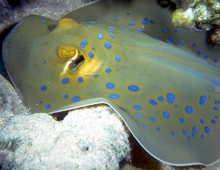Description: The colorful Blue-dot stingray has a smooth, oval-shaped body with bright blue spots scattered on top which varies from yellowish- brown, rust, gray and olive-green. The spots vary in size. The eyes are bright yellow with their large spiracles located directly behind their eyes. The middle of the body is somewhat raised, flattening out towards the edge. The long, broad tail has two blue stripes running along each side and two sharp venomous spines. The snout is rounded; gills and mouth are located on the underside. Two plates inside the mouth allow the stingray to crush shells of mollusks and crabs.
Size: They grow to approximately 10-12 inches (25-30 cm) in diameter. The tail can be almost as long as the body length.
Behavior: These bottom-dwellers are usually found alone or in small groups in shallow waters near coral reefs where they may bury themselves in the sandy bottoms with only their eyes showing, to hide from predators. Movement is mainly by the use of its pectoral fins.
Diet: They forage in shallow sandy areas where they feed on mollusks, shrimp, crabs, benthic bony fish and polychaete worms. Prey is pinned between their body and the substrate, then moved into their mouths.
Senses: The position of the large eyes allows for a wide angle of view of their surroundings.
Communication: They communicate with other Blue-dot stingrays by use of electroreception (ampullae of Lorenzini). This can also be used to detect prey and would-be predators. The bright spots of the Blue-dot stingray serves to warn that it is venomous.
Reproduction: After internal fertilization, embryos are nourished by the yolk; eggs remain inside the female until they hatch; females give live birth to up to seven young (ovoviviparous). The young are encased in a thin layer of skin in order to not injure the mother during birth. It is believed that the gestation may vary between three to four months, or possibly longer.
Habitat/range: They are found in the tropical Indian and western Pacific Oceans in nearshore and coral reef habitats. They prefer sandy and sedimentary substrates.
Status: This species is listed as Near Threatened by IUCN. Threats include destruction of its reef habitat and its demand for the aquarium fish trade.



